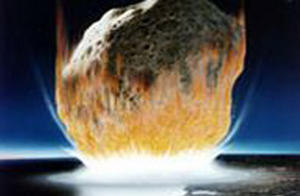Planetary securityOcean-landing asteroid will create huge ozone holes
To date, 818 asteroids that are at least 1-km wide have been discovered on orbits that could take them close to Earth; if a 1-km wide asteroid were to land in the ocean, it would create a big splash, throwing 42 trillion kilograms of water and vapor — enough to fill sixteen million Olympic-sized swimming pools — across an area more than 1,000 kilometers wide and up to hundreds of kilometers above the Earth’s surface; this will result in the destruction of the ozone layer above the Earth’s atmosphere, exposing humans, animals, and plants to civilization-threatening levels of UV radiation

Artist's rendering of an asteroid's ocean landing // Source: sanfranciscosentinel.com
If a medium-sized asteroid lands in the ocean, tsunamis will not be the only worry. A new computer simulation suggests that the water vapor and sea salt thrown up by the impact could damage the Earth’s protective ozone layer, leading to record levels of ultraviolet radiation that could threaten human civilisation.
“This suggests new issues you could have with ocean impacts that people hadn’t thought of before,” says Brian Toon of the University of Colorado at Boulder, who was not involved in the work.
Elisabetta Pierazzo of the Planetary Science Institute in Tucson, Arizona, and colleagues used a global climate model to study how water vapor and sea salt thrown up from an impact will affect ozone levels for years after the event.
They focused on medium-sized asteroids, either 500 meters or 1-kilometer wide. To date, 818 asteroids that are at least 1-km wide have been discovered on orbits that could take them close to Earth.
Olympic splash
Rachel Courtland writes that these objects are on orbits that give them a very small probability of hitting Earth in the near future. Estimates of the asteroid population suggest, however, that dozens more have yet to be found, with unknown orbits that could intersect with the Earth.
To get a sense of how much water might be jettisoned into the atmosphere if these asteroids hit the ocean, the team modeled what would happen if they reached Earth’s atmosphere at a clip of eighteen kilometers per second, an average speed expected for a near-Earth object, and hit the ocean in the northern hemisphere at a 45-degree angle.
As expected, the simulations showed that the larger, 1-km asteroid created the bigger splash, throwing 42 trillion kilograms of water and vapor – enough to fill sixteen million Olympic-sized swimming pools – across an area more than 1,000 kilometers wide and up to hundreds of kilometers above the Earth’s surface.
Engulfing Earth
Once in the atmosphere, the water, together with compounds containing chlorine and bromine from vaporized sea salts, destroyed ozone above the Earth’s atmosphere at a much faster rate than it is naturally created.
Some simulated impacts created depletions that were still felt across the whole Earth a year later. “It will produce an ozone hole that will engulf the entire Earth,” Pierazzo says.
The longest lasting and most severe depletion — a cut of more than 70 percent in ozone levels — occurred over much of the northern hemisphere.
This is a far bigger hole than the one that was above the South Pole in 1993, when Earth’s ozone layer was at its thinnest. The resulting ultraviolet-radiation levels would be higher than anywhere on Earth today, the team writes, presenting a new hazard for human civilization.
Dry hits
While people may be able to protect themselves from the increased threat of sunburn, the intense UV light could also affect our food supply by damaging plants and the phytoplankton that represent the bottom of the ocean’s food chain. “That is enough to really cause problems for our civilization,” Pierazzo says.
Better understanding these effects could help us prepare in the event of an impact. For example people could plant crops more resistant to UV radiation, she adds.
Toon notes that impacts on land or shallow water may ultimately do more damage by kicking up dust that could significantly darken skies and inhibit plant growth. Pierazzo is now working on a model to assess how asteroids that hit dry land would affect the atmosphere.
—Read more in E. Pierazzo et al., “Ozone perturbation from medium-size asteroid impacts in the ocean,” Earth and Planetary Science Letters (2 October 2010) (doi:10.1016/j.epsl.2010.08.036)
